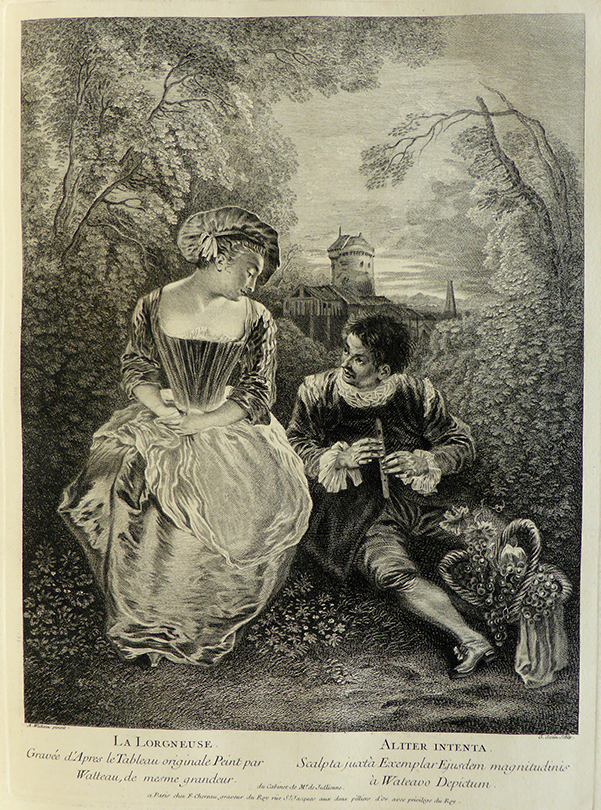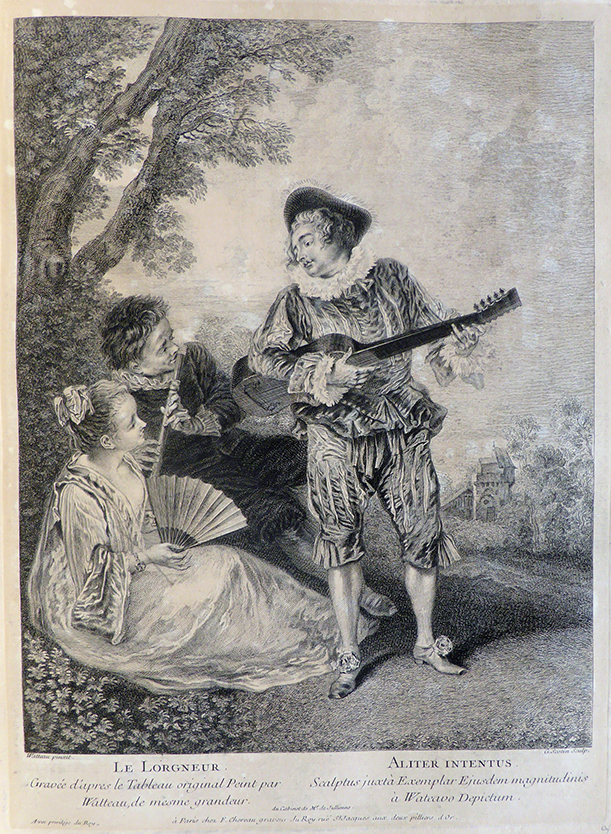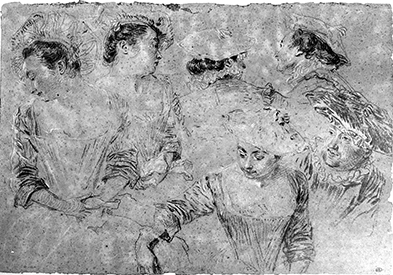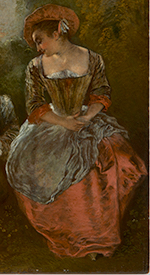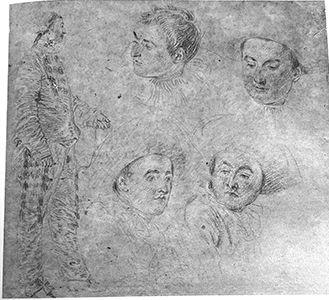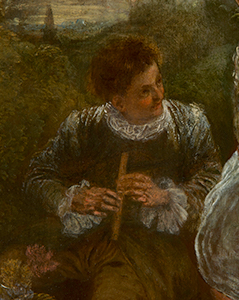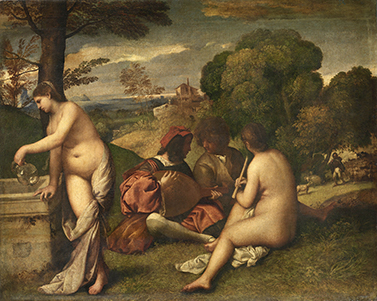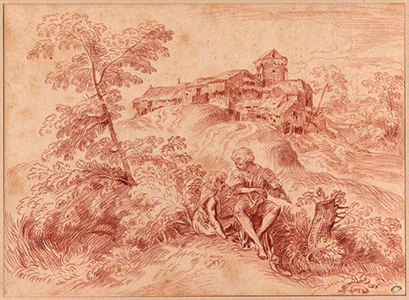
- Home Page
- Accepted
Paintings & Copies - Doubtful
Attributions - Doubtful Textual References
- Alternative
Titles - Collectors &
Museums - Bibliography
- Search Abecedario
- Watteau &
His Circle
La Lorgneuse
Entered July 2020; revised December 2021
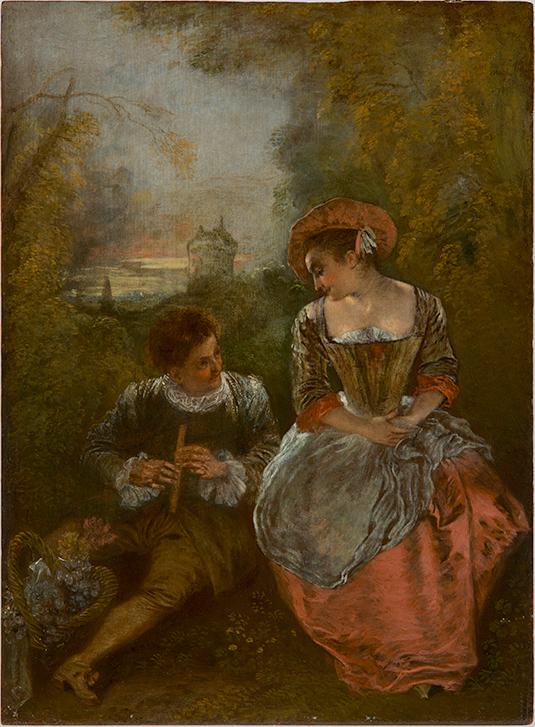 Photo: Natalja Kent
Photo: Natalja Kent
Los Angeles, Collection of Ariane and Lionel Sauvage
Oil on panel
32.6 x 23.8 cm
ALTERNATIVE TITLES
A Masquerade Champêtre
The Music Lesson
RELATED PRINTS
Watteau’s La Lorgneuse was engraved in reverse by Gérard Jean-Baptiste Scotin prior to April 1729. The print was commissioned by Sirois but later was incorporated into Jean de Jullienne’s Oeuvre gravé. The engraving after La Lorgneuse was paired with another engraving, also by Scotin, after a second small musical subject of almost identical dimensions, which was given the name Le Lorgneur. The two paintings were probably never intended to be pendants and soon thereafter were separated, but the engravings memorialized their brief relationship and kinship of names.
PROVENANCE
Paris, collection of Jean de Jullienne (1686-1766; director of a tapestry factory). His ownership of the painting is recorded on the Scotin engraving: “du Cabinet de M. de Jullienne.”
Paris, collection of Germain Louis Chauvelin (1685-1762; marquis de Grosbois, garde des sceaux, Secretary of State for Foreign Affairs under Louis XV). His sale, Paris, June 21ff, 1762, lot 17: “Deux agréables Tableaux, peints sur bois, par Antoine Watteau; ils portent chacun 12 pouces de haut, sur 9 pouces de large. On les trouve gravés sous les titres de La Lorgneuse & de l’Accord parfait, le premier par Scotin, le second par Baron.” The two paintings sold together for 304.19 livres to Jean-Baptiste le Rebours, according to an annotated copy of the sale catalogue at the Los Angeles County Museum of Art.
Paris, collection of Jean-Baptiste August II le Rebours [Rebourg] de Saint-Mard (1746-1793; président de la troisième Chambre des enquêtes). His sale, Paris, April 27ff, 1778, lot 32: “Un autre tableau de Watteau, composé d’un homme qui tient une flûte à côté d’une femme qui le regarde. Il est peint sur bois, hauteur 11 pouces 9 lignes, largeur 9 pouces.” Its previous pendant, L’Accord parfait, appeared separately as lot 31 and was sold to “Lebrun cadet;” Lebrun must also have bought lot 32, since the two paintings were still together in his 1778 sale.
Paris, with Jean-Baptiste Pierre Lebrun (1748-1813; painter and art dealer). His sale, December 10, 1778, lot 110: “Une jeune fille assise, la tête penchée, regardant un homme assis plus bas qui tient un flageolet. Le fond offre un paysage. Ce Tableau est coloré comme de Titien. H. 12 pouces, largeur 9 pouces. B.” Sold for 97 livres, while its unannounced pendant, L’Accord parfait (lot 109) brought 1,300 livres.
Paris, collection of Mathieu François Joseph Devouge (b. c. 1745/50; art dealer). His sale, Paris, March 15ff, 1784, lot 119: “PAR LE MÊME [ANTOINE WATTEAU] . . . Un Paysage, dans lequel on voit un homme tenant une flute & assis près d’une femme avec laquelle il converse. Ce tableau piquant, a été gravé dans le temps qu’il appartenoit à M. de Jullienne, par Scotin. Hauteur 12 pouces sur 9. B.” Bought by Joseph Alexandre Lebrun for 130 livres.
Paris, with Jean-Baptiste Pierre Lebrun (1748-1813; painter and art dealer). His sale, Paris, April 11ff, 1791, lot 202: “PAR LE MÊME [ANTOINE WATTEAU] . . . Un Paysage éclairé par le soleil couchant, où l’on voit sur le devant un homme assis aux pieds d’une femme, aussi assise, qui le regarde, tandis qu’il paroît se disposer à jouer d’une flûte qu’il tient. Ce tableau est d’une belle couleur, et tient beaucoup de Titien.—Hauteur 11 pouces et demi; largeur, 16 pouces. B.” Sold to Henry Walton for 121 francs, according to an annotated copy of the sale catalogue in the Bibliothèque nationale, Paris.
London, with Henry Walton (1746-1813; painter and dealer).
London, collection of Thomas Baring, Bart. (1772-1848). His sale, London, Christie’s, June 2-3, 1848, lot 85: “WATTEAU. . . . A MASQUERADE CHAMPÊTRE—the companion.” L’Accord parfait was the companion (lot 84).The Rijksbureau’s copy of the sale catalogue is annotated “48 [for 84] & 85 Both Small landscapes.”
The Netherlands, a private collector. His sale, Paris, Hôtel des ventes, February 6, 1852, lot 15: “WATTEAU . . . Paysage avec un jeune homme jouant de la flûte près d’une jeune fille. La gravure accompagne le tableau.”
London, collection of Sir Samuel Rogers (1763-1855). His sale, London, Christie’s, April 28-May 10, 1856, lot 596: “WATTEAU. . . . A lady, in a red dress, seated on a bank, a cavalier playing on a [f]lute at her side. Most brilliantly coloured. The engraved picture.” Sold for 140 guineas to Agnew’s.
London, with Agnew’s; sold to Thomas Birchall on May 23, 1856.
Preston, Ribbleton Hall, collection of Lieutenant Colonel Thomas Birchall (c.1809-1878; solicitor and mayor of Preston); by descent to his wife, Mary Rothwell. His sale and others, London, Christie’s, February 6, 1904, lot 150: “A. WATTEAU . . . THE MUSIC LESSON / On panel—12½ in. by 9 in. Sold for £283.10 to Lesser according to the annotated copy of the sale catalogue in the National Art Library, Victoria and Albert Museum.
London, with Lesser; sold to Robertson.
London, collection of Forbes Robertson; sold December 23, 1904, to Sedelmeyer for 13,130 francs.
Paris, Galerie Sedelmeyer, sale, May 16-18, 1907, lot 254: “WATTEAU (ANTOINE) . . . La Lorgneuse. Au fond du parc, il se sont tous deux arrêtés: elle en coquets atours, jupe rose, robe bleue relevée, corsage décolleté rayures brunes et parement rouge, chapeau rose sur ses cheveux bruns; elle est assise et tourne la tête de profil à gauche, regardant avec une complaisance affectueuse le galant assis près d’elle, mais en contre-bas. Celui-ci, en habit bleuté, frais souple de batiste blanche, culotte jaune, s’interrompt de jouer du flageolet, pour contempler sa jolie compagne.
Près de lui, il a posé un panier où se trouvent des raisins noirs et les éléments d’une collation.
Au fond, sous le ciel lumineux et chaud, se dresse une construction. / Panneau. Haut., 0,32; larg., 0,235. Gravé par Scotin. / Décrit par les Goncourt, Watteau, p. 123, no 147. / Collection de M. Jullienne, Paris. / Collection Chauvelin, Paris, 1762. / Collection Lebrun, Paris, 1778. / Collection Samuel Rogers, Londres, 1856.” Bought by Gustave Dreyfus for 18,000 francs for Heughel, according to an annotated copy of the sale catalogue (sold for $3,600, according to American Art News).Paris, sale, November 23, 1927, lot 53: “Jean-Antoine WATTEAU (École de) . . .La Lorgneuse. Une jeune femme est assise, à droite, sur un tertre près d’un bosquet. En jupe rose, robe bleue, corsage rayé de brun décolleté en carré, elle regarde un galant assis, en contre-bas, qui s’interrompt de jouer du flageolet pour lui sourire. A ses pieds, une corbeille de raisins; au fond, une construction sous le ciel lumineux.
Bois. Haut., 32 cent.; larg., 23 cent.5. Cadre en bois sculpté. Composition gravée par G. Scotin. Cf. Jean de Jullienne et les graveurs de Watteau au XVIIIe siècle, par ÉMILE DACIER et ALBERT VUAFLART, p. 12, no 13.”Paris, private collection by 1950. By descent within the family.
Sale, London, Christie’s, July 9, 2015, lot 25: “JEAN-ANTOINE WATTEAU . . . La Lorgneuse / oil on panel, unframed / 12 7/8 x 9 3/8 in. (32 x23.8 cm.) / £300-500,000 $470,000-780,000 / €430,000-700,000
PROVENANCE: Jean de Jullienne (1686-1766), Paris. Germain-Louis Chauvelin, Marquis de Grosbois (1685-1762), ministre d’état, commandeur des orders du roi & ancient gardes des sceaux; his sale, Hôtel de M. Chauvelin, Paris, 21 June 1762, lot 27, as one of a pair, with L’Accord parfait: ‘Deux agréables Tableaux, peints sur bois, par Antoine Watteau; ils portent chacun 12 pouces de haut, sur 9 pouces de large. On les trouve gravés sous les titres de La Lorgneuse & de l’Accord parfait, le premier par Scotin. Le second par Baron.’ (304 livres 19 deniers for the pair). M. le Rebourg; his sale, l’Hôtel de feu M. le Président le Rebourg, Paris, 27 April 1778, lot 32. (Possibly Jean-Baptiste-Pierre Le Brun (1748-1813); his sale, une Salle des Révérends Peres Augustins du Grand Couvent, Paris, 12 December 1778 [= 3rd day], lot 110 (97 livres to anonymous). with Mathieu-François-Louis Devogue [sic]; his sale, Hôtel de Bullion, Paris, 15 March 1784 [=1st day], lot 119 (130 livres to Joseph-Alexandre Le Brun). Jean-Baptiste-Pierre Le Brun (1748-1813); his sale, rue de Cléry, no. 95, (Paris, 14 April 1791, lot 202, where described as ‘…d’une belle couleur, et tient beaucoup du Titien (122 livres to Henry Walton). Sir Samuel Rogers (1763-1855), London, by 1831; his sale(†), Christie’s, London, 28 April-10 May 1865 [5th day], lot 596 (140 gns. To the following), with Agnew’s, London, where acquired on 23 May 1856 by Lt. Col. Thomas Birchall, Ribbleton Hall, Preston, R.R. Rothwell [on behalf of Thomas Birchall]; Christie’s London, 6 February 1904, lot 150 as ‘The Music Lesson’ (170 gns. to Lesser). F. Robertson, from whom acquired by Charles Sedelmeyer, Paris, 23 December 1904 (13,130 francs); his sale, Galerie Sedelmeyer, 4 rue de la Rochefoucauld, Paris, 16-18 May 1907, lot 254 (18,000 francs to Gustave Dreyfus for the Compte de Heughel). Private collection, Paris, by 1950, and by descent to the present owner.
LITERATURE . . . .” Sold for £782,500.
EXHIBITIONS
Paris, Galerie Sedelmeyer, 10th Series of 100 Paintings (1906), cat. 77.
Eidelberg, Rêveries italiennes (Valenciennes, 2014).
SELECT BIBLIOGRAPHY
Mariette, “Notes manuscrites,” 9: fol. 193.
Hédouin, “Watteau” (1845), cat. 62.
Hédouin, Mosaïque (1854), cat. 63.
Goncourt, L’Art au XVIIIème siècle (1860), 57.
Goncourt, Catalogue raisonné (1875), cat. 147.
Mollet, Watteau (1883), 69 n. 1.
Philips, Watteau (1895), 42.
Staley, Watteau (1902), 69.Josz, Watteau (1903), 322.
“Foreign Sales of the Month” (1907), 10.
Dacier, Vuaflart, and Hérold, Jean de Julliene et les graveurs (1921-19), 2: 65, 97, 121, 159; 3: cat. 13
Réau, “Watteau” (1928), cat. 105.
Adhémar, Watteau (1950), cat. 166.
Mirimonde, “Sujets musicaux chez Watteau” (1961), 270.
Eidelberg, Watteau’s Drawings (1965), 66.
Macchia and Montagni, Tutti l’opera di Watteau (1968), cat. 103.
Roland Michel, Watteau (1981), cat. 144.
Posner, Watteau (1984), 154.
Roland Michel, Watteau (1984), 266, 287.
Whittingham, “Watteaus and ‘Watteaus’” (1987), 272.
Rosenberg and Prat, Watteau, catalogue raisonné des dessins (1996), 2: cat. 455, 482, 516.
Valenciennes, Watteau et la fête galante (2004), under cat. 56.
Michel, Le «celebre Watteau» (2008), 137, 183, 254.
Turner and the Masters (2009), 174-77.
Ziskin, Sheltering Art (2012), 117.
Brussels, Watteau, Leçon de musique, cat. 40 and under cat. 41.
RELATED DRAWINGS
The upper portion of the woman in La Lorgneuse was derived from a beautiful sheet of studies in the Louvre (Rosenberg and Prat 482). The figure at the far left was used for the painting, without change. One might wonder if the artist relied on a separate study for the skirt and shoes.
There is no comparably complete study of the man. His head alone is recorded at the top center of a sheet of studies in the Musée Bonnat in Bayonne (Rosenberg and Prat 516), but in reverse. Watteau must have availed himself of a counterproof for the painting.
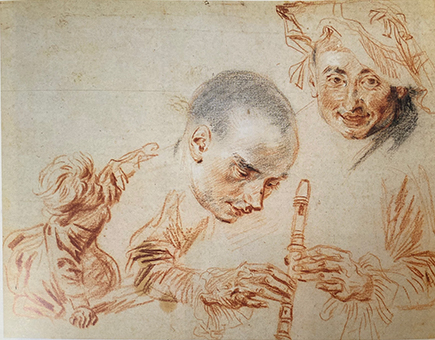
Watteau, Two Studies of a Man and a Young Girl, red, black, and white chalk, 20.4 x 25.4 cm. Amsterdam, Rijksmuseum, Rijksprentenkabinett.
A third drawing contributed the study of hands and flute needed to fill out the flutist in the painting (Rosenberg and Prat 455). Perhaps not coincidentally, the study of the girl at the left side of the sheet was used for a variant of Le Lorgneur, the painting known as Les Délassements champêtres.
REMARKS
The painting’s provenance is relatively straightforward, but various accounts have woven into it additional and erroneous data. For instance, Edmond de Goncourt, followed by Josz, claimed that a version of the painting had been sold in an auction of Le Brun’s stock in 1806, lot 202. However, lot 202 in that sale does not correspond to La Lorgneuse, nor do some other Watteau paintings in that sale. According to Goncourt, the painting measured 16 pouces in width, more than twice the size of the original Watteau. It must have been a variant and not the original version.
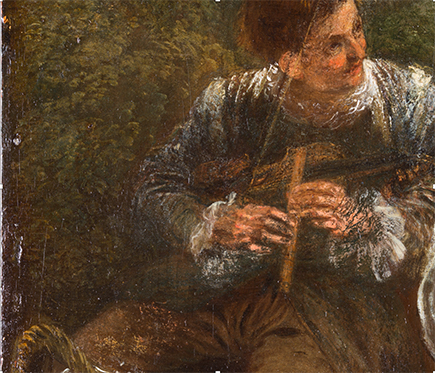
Detail of Le Lorgneur showing the violin revealed in the recent cleaning. Photo: Natalja Kent.
A recent cleaning of the painting has revealed an exciting pentimento: originally the flutist was a violinist. He evidently held a violinist in front of his chest, much as he holds the flute in the present picture.
The dating of Watteau’s painting has centered around the midpoint of his career. Macchia and Montagni, Roland Michel, and the catalogue for the exhibition Leçon de musique favored c. 1715; Adhémar suggested late 1716; Rosenberg and Prat placed the drawing of the woman in 1716 and the head of the flutist in 1716-17, which constitutes the latest date that has been proposed.
Despite the unfortunate title of La Lorgneuse (the Ogling Woman, the name given to the Jullienne engraving), the picture belongs to an old and noble tradition. In particular, Venetian Renaissance art turned to pictures of intimate concerts, whether among shepherds or courtiers, whether well-dressed or classically nude. Certainly Watteau was well-acquainted with this Venetian tradition, as his many drawings after Titian and Campagnola attest. The Venetian-inspired buildings set back in the landscape of La Lorgneuse and the rich coloration of the sunset sky emphasize this aspect of the artist’s work. Nor was this Venetian association lost on his contemporaries. When La Lorgneuse was sold in 1778, it was declared that “Ce Tableau est coloré comme de Titien.” In 1791, it was again described as “d’une belle couleur, et tient beaucoup de Titien.”
Contemporary critics have been more concerned with uncovering sexual innuendos in Watteau’s art and especially in paintings such as La Lorgneuse. The directions of the characters’ gazes, the phallic shape of a flute—these are the elements they dwell on. Mirimonde reads the painting as showing that the song is finished and the woman has been conquered. While Posner objected to Mirimonde’s overinterpretation (his term), he presents the composition as showing the musician as having ended his song and the woman gazing at him, about to make her decision. Moreover, Posner goes on to describe the basket of grapes as “a symbol of amorous pleasures to be taken.” Such readings of Watteau’s art wrongly suppose that the painter was a visual novelist like Hogarth, although nothing could be farther from the truth. He is a poet whose evocative art suggests a mood but not a plot.
Click here for copies of La Lorgneuse.
